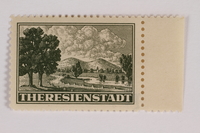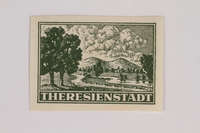Overview
- Brief Narrative
- canceled parcel admission stamp for Theresienstadt ghetto-labor camp, depicting the surrounding landscape of Bohemia. The camp was established by the Germans in November 1941 about 40 miles north of Prague in the Protectorate of Bohemia and Moravia created after Nazi Germany occupied the western region of Czechoslovakia in March 1939. It was a multi-use camp, acting as a settlement, transit camp, and propaganda tool. The stamp, which was printed in Prague, was issued by the Prague Jewish Council beginning in July 1943. Inmates at Theresienstadt could receive inspected packages of food and clothing from people outside the camp if the packages had this stamp. An inmate could request a package every two months. The Jewish Council in Prague would notify the sender to come pick up the stamp if they lived in Prague; if they lived outside of Prague, the stamp would be attached to the notice. Living conditions in the camp were horrible and about 33,000 inmates died there. On May 2, 1945, as the end of the war approached, the International Red Cross took over administration of the camp. The German staff fled on May 5 and 6, and on May 9, Soviet troops arrived and assumed responsibility.
- Date
-
issue:
after 1943 July-before 1945 May 02
- Geography
-
use:
Theresienstadt (Concentration camp);
Terezin (Ustecky kraj, Czech Republic)
issue: Prague (Czech Republic)
- Credit Line
- United States Holocaust Memorial Museum Collection, Gift of Hal and Robyn Klein
- Markings
- front bottom, printed, white on green background : THERESIENSTADT
Physical Details
- Language
- German
- Classification
-
Exchange Media
- Category
-
Postage stamps
- Object Type
-
Postage stamps (lcsh)
- Physical Description
- canceled rectangular white paper stamp with perforated edges and a pastoral landscape printed in dark green ink. In the left foreground are two large trees, with a winding road and a river to the right. In the background under a cloud filled sky are 2 mountains with a building with a tower at the foot, surrounded by trees. The image is enclosed in a green border with the place name across the bottom. There are 4 circular cancellation stamps on the front, one in each corner, with partially legible letter and numbers.
- Dimensions
- overall: Height: 1.125 inches (2.858 cm) | Width: 1.500 inches (3.81 cm)
- Materials
- overall : paper, ink
- Inscription
- front top right corner, stamped, black ink : - 4 [?] V 5 17 / PRAHA 33
front bottom right corner, stamped, black ink : PRA [?] / IV 4 5-1 [?]
front top left corner, stamped, black ink : IV 45- [?] / RAHA 33
front bottom left corner, stamped, black ink : [?]
Rights & Restrictions
- Conditions on Access
- No restrictions on access
- Conditions on Use
- No restrictions on use
Keywords & Subjects
- Topical Term
- Holocaust, Jewish (1939-1945)--Czech Republic--Terezin (Ustecky kraj) Postal service--Czech Republic--Terezin (Ustecky kraj)--History--1938-1945. Postage stamps-Czech Republic--Terezin (Ustecky kraj)--History--1938-1945. World War, 1939-1945--Czech Republic--Terezin (Ustecky kraj)--Postal service--1938-1945.
- Geographic Name
- Czechoslovakia--postal service--History--1938-1945.
- Corporate Name
- Theresienstadt (Concentration camp)
Administrative Notes
- Legal Status
- Permanent Collection
- Provenance
- The postal stamp was donated to the United States Holocaust Memorial Museum in 2012 by Hal and Robyn Klein.
- Funding Note
- The cataloging of this artifact has been supported by a grant from the Conference on Jewish Material Claims Against Germany.
- Record last modified:
- 2024-01-05 14:42:54
- This page:
- https://collections.ushmm.org/search/catalog/irn76776
Download & Licensing
In-Person Research
- By Appointment
- Request 21 Days in Advance of Visit
- Plan a Research Visit
- Request to See This Object
Contact Us
Also in Hal and Robyn Klein collection
The collection consists of an unused Star of David patch, three Theresienstadt ghetto labor camp parcel stamps, and a letter relating to the history of the Holocaust in German occupied Czechoslovakia and Netherlands.
Date: after 1942 May-1965

Unused parcel admission stamp for Theresienstadt ghetto-labor camp
Object
Unused parcel admission stamp for Theresienstadt ghetto-labor camp, depicting the surrounding landscape of Bohemia. The camp was established by the Germans in November 1941 about 40 miles north of Prague in the Protectorate of Bohemia and Moravia created after Nazi Germany occupied the western region of Czechoslovakia in March 1939. It was a multi-use camp, acting as a settlement, transit camp, and propaganda tool. The stamp, which was printed in Prague, was issued by the Prague Jewish Council beginning in July 1943. Inmates at Theresienstadt could receive inspected packages of food and clothing from people outside the camp if the packages had this stamp. An inmate could request a package every two months. The Jewish Council in Prague would notify the sender to come pick up the stamp if they lived in Prague; if they lived outside of Prague, the stamp would be attached to the notice. Living conditions in the camp were horrible and about 33,000 inmates died there. On May 2, 1945, as the end of the war approached, the International Red Cross took over administration of the camp. The German staff fled on May 5 and 6, and on May 9, Soviet troops arrived and assumed responsibility.

Counterfeit parcel admission stamp for Theresienstadt ghetto-labor camp
Object
Counterfeit parcel admission stamp for Theresienstadt ghetto-labor camp, depicting the surrounding landscape of Bohemia. The camp was established by the Germans in November 1941 about 40 miles north of Prague in the Protectorate of Bohemia and Moravia created after Nazi Germany occupied the western region of Czechoslovakia in March 1939. It was a multi-use camp, acting as a settlement, transit camp, and propaganda tool. The stamp, which was printed in Prague, was issued by the Prague Jewish Council beginning in July 1943. Inmates at Theresienstadt could receive inspected packages of food and clothing from people outside the camp if the packages had this stamp. An inmate could request a package every two months. The Jewish Council in Prague would notify the sender to come pick up the stamp if they lived in Prague; if they lived outside of Prague, the stamp would be attached to the notice. Living conditions in the camp were horrible and about 33,000 inmates died there. On May 2, 1945, as the end of the war approached, the International Red Cross took over administration of the camp. The German staff fled on May 5 and 6, and on May 9, Soviet troops arrived and assumed responsibility.
Unused Star of David badge imprinted with Jood, Dutch for Jew
Object
Square yellow cloth printed with a Star of David with badge cutting guidelines and the word Jood, an example of the type of badge distributed in German occupied Netherlands. The stars were issued on rolls of cloth and the user had to cut one out along the guidelines to make a badge to attach to their clothing. Following the German invasion of the Netherlands on May 10, 1940, a civil administration under the authority of the SS was installed. Anti-Jewish legislation was enacted within two months. On April 28, 1942, a decree was issued ordering that all Jews in the Netherlands over the age of six must wear a yellow Star of David badge. The decree was published in newspapers on the 29th and enforced on May 1, 1942. The German appointed Jewish Council was responsible for distributing the patches, which were to be worn on the outer clothing at all times. The badges were used to make it easy to identify Jews and to ostracize them from Dutch society. The Netherlands was liberated on May 5, 1945.



